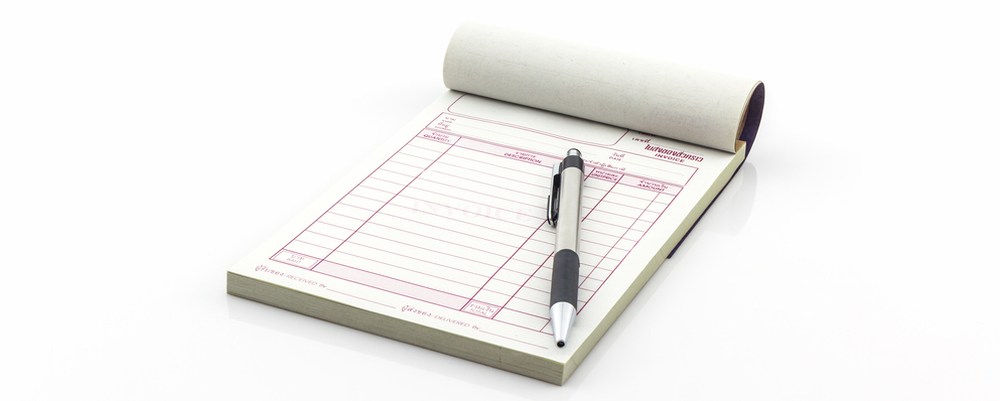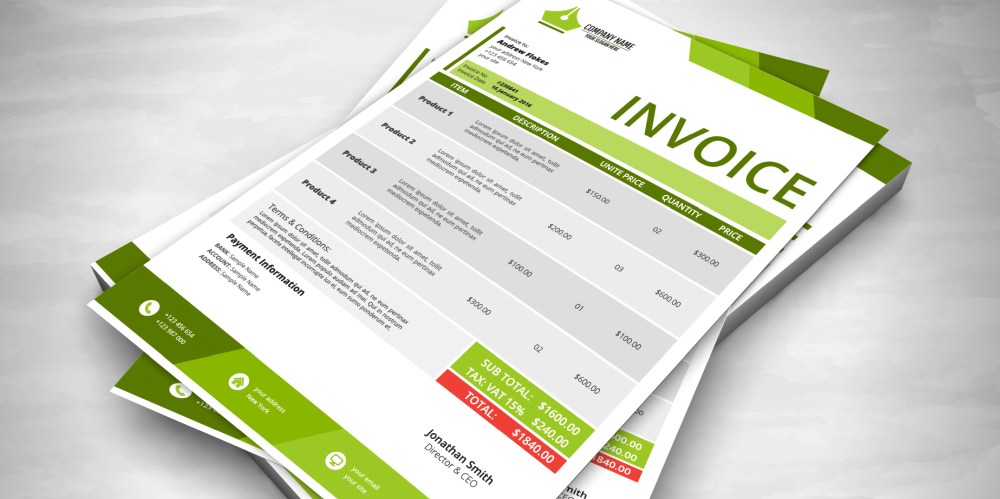There are several ways you can create an invoice for your customers. You have the more traditional way of writing them out by hand, or you can utilize invoice software and free templates to generate them and get them sent out. If you’re curious about the different invoice methods, we’re going to outline several different types below. This way, you’ll be able to decide which one will work best for your business and incorporate it into your systems.
Traditional Ways for Creating Invoices
There are two main traditional ways to create invoices for your customers and vendors. Many older business owners use these methods because it’s familiar to them. They’re rare today because many invoice creator software are so user-friendly, but you can find them now and again.
Manually Input Your Data
You can work off one set template and manually input all of your data. It can be a hard copy or on a simple template that you type out and print. You have to put all of your items into your products or services in one by one, list the costs, and total it all up at the bottom of the template.
While there is a slightly lower risk of errors because you’re checking everything as you put it in, it can be a time-consuming process. It’s also slightly impractical for larger businesses that process hundreds of invoices each day.

Pen and Paper
Believe it or not, some people still prefer to write out their invoices with traditional pen and paper. You can get paper books that come with a basic invoice template, and you simply fill in the relevant information with each customer. They usually have lines where you can list your products or services and the quantity.
You’ll also list the prices in the correct area with an overall total at the bottom plus any taxes you charge. These invoice books can come with the business name, address, and phone number as well. Again, they’re time-consuming to fill out, but you reduce your risk of errors.
Electronic Ways for Creating Invoices
Technology has come a long way in all areas, and this includes offering free invoice software and downloadable free invoice templates. Many large and small businesses made the switch to electronic invoice creation because it saves time, and you can usually automatically populate your fields and send them out through email.
Template with a Text Editor
One of the most simple electronic ways to create invoices involves getting one or two templates and opening them in your preferred text editor. There are fields that allow you to input your items, services, quantities, and the total cost. You can customize these templates to display your business’s name, address, phone number, email, and any other relevant information.
Since it’s electronic, it also opens the door for email delivery, or you can print it out and hand it directly to your customer or vendor. It helps your business to project a sleek and current image.

Spreadsheet Invoice Template
Spreadsheet invoice templates are very popular with both large and small businesses alike that send out several invoices every day. You can build your own invoice template in Excel, or you can choose a free template and import it into your spreadsheet program.
Once you get all of your business’s information in and saved, you can use the same template over and over again. All you have to do is populate the fields with a description of your products or services, the quantity, price, and the final amount in a total column. They’re straightforward, fast, and they give you a uniform look.
Accounting Software
Depending on the accounting software you use, they can automatically generate invoices with everything populated into the correct fields when your accounting team works on your business’s books.
Businesses like this type of software because it can show them in real-time how their budget is, how high their expenses are, and how much money they have coming in and going out with each invoice. It can also help you keep track of multiple invoices for different customers or vendors at the same time, and it reduces the chances of errors because your team looks them all over.
Simple Online Invoice Generator
Simple and interactive online invoice generators are gaining popularity very quickly. They let you choose your language of choice, currency, date format, tax labels, color, and the template you’d like to use. You can add your supplier and customer information with a few quick clicks, and they have the issue date, due date, and a numbering system to help you keep track of multiple invoices at once.
You can also find invoice generators that let you add notes and greetings, set reminders, and accept credit card payments. They come designed to be very user-friendly and comprehensive, and this can help you get your money quicker.
Invoice Management App
Finally, we have invoice management apps. Gone are the days of struggling to make your invoices, send them out, keep them all organized, and double check that you get payments on all of them. Instead, businesses now have the option of choosing invoice management apps like Billdu to take care of the hard work for them.
This app lets you create and send invoices with a few clicks, know when your clients see your invoices, set payment reminders, and give your customers the opportunity to pay right away. There’s also a mobile invoice app that lets you manage and keep track of your invoices when you’re on the go. Nevertheless, using an invoice app such as Billdu can automate the creation of recurring invoices, saving you a lot of time and hassle.
Comparing Traditional vs. Electronic Invoice Systems
Now that we’ve outlined the seven most popular ways businesses create free invoices, we want to make a quick comparison of the traditional vs. electronic invoicing systems. If you don’t have a system in place, this can help you decide which one is a more viable option for your business to use.
Storage Space
It’s far cheaper and easier to store electronic invoices over paper invoices. All you need to store your electronic invoices is a computer system. Paper invoices require file cabinets and constant upkeep to keep them neat. Most electronic systems automatically have organizational settings you can use to search for your invoices by name or number without having to try and go through hundreds of papers one by one.
Ease of Use
Sharing and finding paper invoices can be a time-consuming process. If your customer isn’t at your business and they request a copy, you either have to mail it out or scan it in, attach it to an email, and send it off. With electronic systems, it’s usually a few clicks of a button to bring up the invoice and get it on the way to the customer. You can also share them between computer systems almost instantly.
Labor Costs
You have to have staff in place to help manage your paper invoices. Your staff has to correctly file, collate, match information, staple check stubs or money order copies to the invoices, pull them when there is a new payment, and keep track of old invoices. With electronic systems, the software usually does this for you, and it uses a fraction of the labor that you’d use with a paper system.
Locating Time
It’s very easy to misplace, misfile, or outright lose paper invoices. This can result in hours of fruitless searching if you have to pull them up for any reason, and losing an invoice is paramount to the work or service never making it to the client if they choose to dispute it. Electronic documents usually with come with some ability to search for them. You can search by invoice number, customer, date range, and more.
Portability
How easy is it to pick up your laptop or even your phone and take it with you? If you have an app linked to your record system, being able to view your invoices is as easy as pulling out your phone. Paper invoices mean that you have to store and transport boxes or folders of invoices each time you move, and electronic invoices are much more portable for everyone involved.
Change Tracking
Maybe you want to see who made changes or updated your invoices. Unless they sign or initial the paper invoices, you have almost no way of knowing. This is especially true if you have a large department that works on the invoices. Many electronic invoices let you track the different versions, and everyone has a unique identifier that allows you to easily see who made what changes to your invoices.
Reliability
One of the problems with electronic invoices is reliability. If your network should crash, or should you get somewhere that you don’t have access to a computer or phone, you can’t get to your records. If there’s a massive power outage, your information is out of reach. Paper invoices are reliable. You can store them on or off-site, and you always have access to them as long as you can get to where you store them, whether or not you have power.
Accidental Deletion or Theft
Unfortunately, software makes it very easy to accidentally delete large batches of data all in one go. If you don’t have backups or copies stored somewhere, you can quickly be out months of invoices. It’s harder to accidentally toss out months or years of paper documents. Also, it’s more difficult to steal large amounts of paper documents without someone knowing. You can hide thousands of digital documents on a small USB.

Pros and Cons of Electronic Invoice Systems
Online invoices come with pros and cons, and you want to get a clear picture of the biggest ones because it can be a big change to switch from traditional invoicing to using free billing software to create your invoices.
Pros of Electronic Invoicing
- Convenience– There is a huge convenience factor with using electronic invoices for both the person sending the invoice and the person receiving the invoice. They can have it in their email in minutes, and you can offer multiple ways to instantly pay in full or a portion.
- Greater Control for Finances – If you accidentally forget to pay an invoice, you’d normally end up paying late fees. However, even if you’re a day before your invoice is due, you can submit an electronic payment that can potentially process by the next day.
- Automatic Reminders– Invoice creators allow you to set automatic reminders if your customers don’t may a payment or pay your invoice in full by the due date. These automatic reminders mean you don’t have to spend as much time chasing after your customers.
- Reduces Overhead – Once you get an electronic invoice system in place, you can lower your costs spent with postage and printing. You won’t use as much ink because you send the invoices straight to email.
Cons of Electronic Invoicing
- Conversion Cost – Depending on the system you choose, it can be very expensive upfront to convert all of your paper invoices to electronic. A way around this would be leaving your paper invoices in their original state and just do electronic invoices going forward.
- Software Compatibility –Not all software or computer systems are compatible. This means that you’ll either have to find an alternative system to use, or you’ll have to upgrade everything.
- Formatting Risks– Not all template formats are compatible, and this means that you may not be able to open them at some point. Currently, Adobe Acrobat (PDF) one of the preferred formats, but if it were to vanish, you wouldn’t be able to open or view your invoices.
- Quality Control – In a perfect world, all of your invoices would be extremely high-quality, have a nice balance, and be very easy to read. However, it can be difficult to maintain this higher quality across all of your electronic invoices.
Try Billdu and Creating Invoices Today for Free!
Are you ready to create professional and sleek free invoices? Maybe you’re wondering how to create invoices that can be stored, reused and automatically aggregated. Either way, we want to help! Try our free invoice generator to start or register for a free trial to get the access to the full Billdu invoice maker features.



